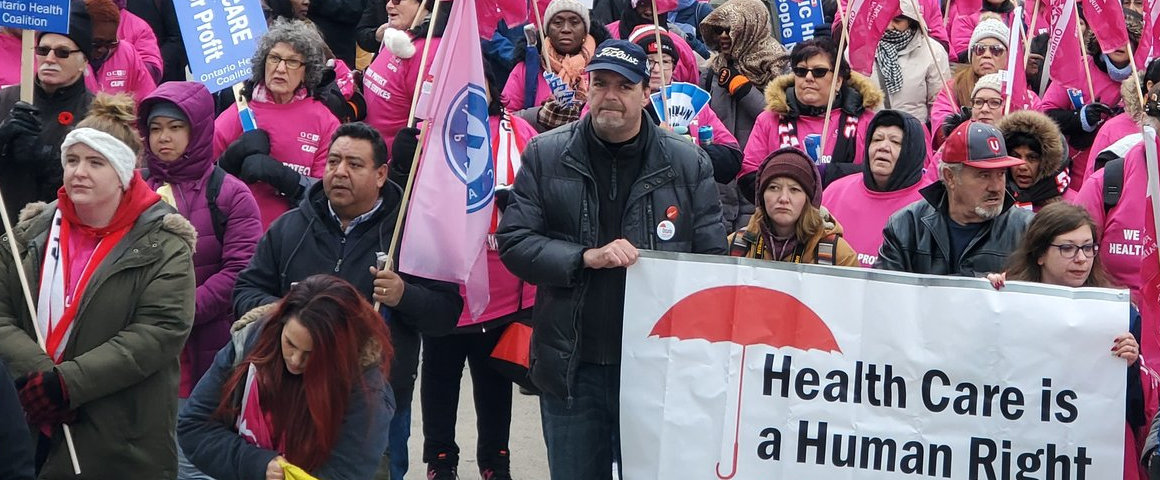By Doug Allan
The Ford government has re-released its spring Budget with a new first quarter fiscal and economic update. Unfortunately, the increases in planned spending compared to the spring Budget are so insignificant that they can be handled within government contingencies. Overall program spending is still exactly as planned in April. Total spending, which also includes the debt expense, is up a modest $105 million due to higher interest rates. As a result, the total spending plan is up by five one hundredths of one percent (0.05 percent).
With increased revenues, the deficit is planned to be $1.1 billion lower and the debt to GDP ratio is also planned to be a full percent lower – a significant reduction.
Keeping with the new health minister’s (preposterous) claim that there is no crisis in healthcare, the spending plan for health, long-term care and COVID is exactly the same as in April, right down to the last penny. That is remarkable given that the healthcare staffing and capacity crisis has hit new levels since April, with emergency room closures and the shutdown of intensive care beds due to a lack of staff.
Staffing Crisis: Healthcare staffing has hit a new level of crisis. Indeed, the Ford PC government has driven healthcare staffing vacancies up to 45,735. That is up 25,495 vacancies since the PCs were elected ― a 126 percent increase. In total healthcare job vacancies are up 35,000 since 2015. The job vacancies are in hospitals (15,095 vacancies), nursing and residential care facilities (16,015) and ambulatory care (1426).
Turnover of hospital staff has hit an unsustainable 14.95 percent for the year ended February 28, 2022. This was primarily driven by a steep increase in resignations – now running at 10 percent of staff annually, more than double what it was.
This staffing crisis comes as the Ford PC government has required (via Bill 124) 1 percent annual wage “increases” for healthcare workers. With inflation running at 7.6 percent, this means a 6 percent real wage decrease this year alone. As this goes to press, tens of thousands of hospital workers are awaiting an interest arbitration award for a new collective agreement. Under the terms of the PC government’s Bill 124, wages and compensation are limited for these workers to 1 percent annually for three years. This is going to make the staffing crisis worse, not better.
Ford’s attack on public sector wages will mainly affect female workers. Hourly wages for all workers in Canada are up 5.4 percent as of August 2022 and Ontario construction workers (who can still feely bargain their wages) are negotiating annual wage increases at an even higher level – as they should.
The PCs continue to focus on radically cutting the wages of healthcare workers even as the staffing crisis shakes the foundations of Ontario healthcare. The only attempt they have made to respond to the staffing crisis is to force vulnerable elders into long-term care homes they don’t want to go into via Bill 7. There is no plan to recruit and retain the tens of thousands of healthcare workers needed right away
Cuts getting worse: The government budgeted Ministry of Health funding below cost pressures in its spring Budget. But with a big cut in a separate line item for the “special COVID health response,” the money planned for health is in fact down by about $94 million overall. So, expect cuts in areas that benefited from COVID funding. And budgeting aside, they are also likely planning to actually spend significantly less on health than they have budgeted.
Keeping the same spending plan as in April means that the cuts in programs will be worse now, as inflation projections are now much higher than when the April Budget was released. As a result, the planned funding will not go as far as thought in April.
The Bank of Canada estimates consumer inflation at 7.2 percent for all of 2022. That is 2.5 percent higher than the 4.7 percent the Ontario government estimated in the April Budget. Inflation for public services may not be hit quite as hard as an extra 2.5 percent, as public sector compensation increases are up less than capitalist price increases. Still the hit from capitalist price increases will be significant.
As usual, the program cuts will likely be mostly seen in cuts in the quality of public services (more work, fewer workers). Austerity governments hate to see the quantity of services cut — that is too easy for opponents to expose and attack. So, they take steps to ensure hospital and other health providers maintain the quantity of services, even while the funding is inadequate. The recent closures of emergency rooms and ICUs just go to show the level of problems we are dealing with ― the cuts are showing up in obvious, quantitative ways.
Misleading estimates likely: This government has excelled at misleading fiscal forecasts ― and they continue on that tack this time around.
Nominal growth is the main driver of taxation revenue growth. They somehow conclude that 9 percent nominal growth this year will lead to only 2.7 percent growth in tax revenues. That is only a growth of $3.4 billion in revenue. Last year’s government Budget figures, however, would lead us to expect roughly $9.9 billion in revenue growth with 9 percent nominal growth (following the long-term trend, they estimated $1.1 billion in extra government revenue for one percent nominal GDP growth).
Compounding this underestimation, the Financial Accountability Office reports they are still underestimating last year’s revenue by $1.6 billion. The government’s lowball figure will have been their base for estimating 2022/23 revenue.
Last year, their Budget revenue estimate was low ― by about $20 billion. That has to be a record miscalculation and, as a result, the deficit, when finalized, will be $20 billion to $25 billion less than they said it would be. But that maneuver helped keep the expectations of working people for decent wage increases and social programs low. They are probably not leading us that far astray this year ― but they are making a significant effort to mislead again.
Bottom line: With this Budget “re-do” expect bigger cuts, bigger workloads and, once all is said and done, higher government revenue, an underspent budget and a lower deficit. That is if they get away with this. If the economy performs as they predict, the government has plenty of room to improve health care and social programs. The trick will be for labour and the community to mobilize sufficiently to require government to do what they don’t wish to do.
Among public services, the major exception to the trend towards planned cuts is long-term care (LTC). Thanks to the decade-long battle by community and labour to increase staffing in LTC, that sector is budgeted for a significant increase ― 13.6 percent (up $810 million).
Whether this government has a plan to actually get the staff is a different matter.
The LTC plan will require tens of thousands of new staff over a few short years and, so far, the government has not shown much inclination to take the steps necessary to achieve that. Their commitment to the suppression of female health care wages is that strong.
The number of nurses working in LTC is down ten percent since 2020 and the number of non-practicing RPNs has more than doubled since 2015. Fourteen thousand nine-hundred Registered Nurses and Registered Practical Nurses in Ontario are non-practicing.
The lack of action on staffing shortages raises serious questions about the ability of this government to add the LTC staffing hours and beds promised (and needed).
Get People’s Voice delivered to your door or inbox!
If you found this article useful, please consider subscribing to People’s Voice.
We are 100% reader-supported, with no corporate or government funding.




